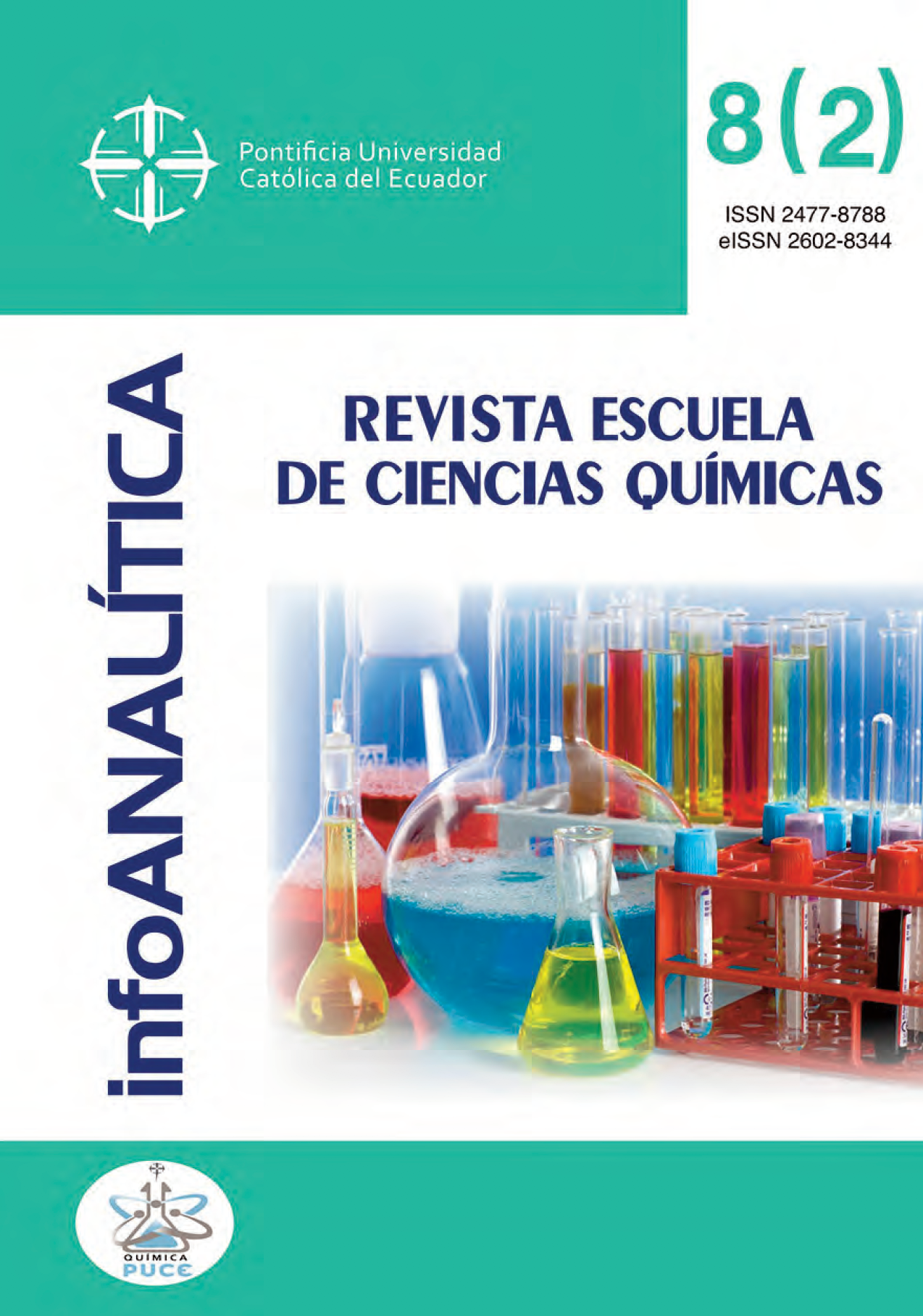Phytochemical screening and structural elucidation of secondary metabolites from picramnia sp. in the ecuadorian amazon
Main Article Content
Abstract
The species of the genus Picramnia are found throughout tropical America, evidencing a wide distribution. In addition, secondary metabolites that some of them exhibit have been described. In the province of Napo, located in the Ecuadorian Amazon, one of the species of this genus is found, whose metabolites have not yet been elucidated. In the present work, the objective was to extract and isolate secondary metabolites from this plant, as well as to characterize them using spectroscopic techniques. For this, the aerial parts of the Picramnia sp. were collected in the Jatun Sacha Biological Reserve. The dried and ground leaves were then macerated consecutively in different solvents, and some of the obtained extracts were partitioned and / or purified by Flash Column Chromatography. Both the dried leaves and the obtained extracts were subjected to qualitative tests to determine the presence of the metabolites of interest. The presence of anthraquinones, tannins, terpenoids, phenols and flavonoids was verified. Finally, β-sitosterol and chrysophanol were identified in purified fractions, which were elucidated using a combination of 1H NMR, 13C NMR spectroscopy and mass spectrometry. It is known that both molecules have various pharmacological activities, among which their antimicrobial activity stands out.
Downloads
Article Details
- The authors agree to respect the academic information of other authors, and to assign the copyrights to the journal infoANALÍTICA, so that the article can be edited, published and distributed.
- The content of the scientific articles and the publications that appear in the journal is the exclusive responsibility of their authors. The distribution of the articles published in the infoANALÍTICA Journal is done under a Creative Commons Reconocimiento-CompartirIgual 4.0 Internacional License.
References
Alves, I. A., Miranda, H. M., Soares, L. A., & Randau, K. P. (2014). Simaroubaceae family: botany, chemical composition and biological activities. Revista Brasileira de Farmacognosia, 24(4), 481-501. https://doi.org/10.1016/j.bjp.2014.07.021
Andoque, H., Andoque, D., Andoque, M., & Andoque, H. (2009). Plantas medicinales de la Gente de Hacha. Universidad Nacional de Colombia-Sede Amazonia.
Aponte, J. C., Vaisberg, A. J., Rojas, R., Caviedes, L., Lewis, W. H., Lamas, G., Hammond, G. B. (2008). Isolation of Cytotoxic Metabolites from Targeted Peruvian Amazonian Medicinal Plants. Journal of Natural Products, 71(1), 102–105. https://doi.org/10.1021/np070560c
Balasundram, N., Sundram, K., & Samman, S. (2006). Phenolic compounds in plants and agri-industrial by-products: Antioxidant activity, occurrence, and potential uses. Food Chemistry, 99(1), 191–203. https://doi.org/10.1016/j.foodchem.2005.07.042
Balderrama, L., Braca, A., Garcia, E., Melgarejo, M., Pizza, C., & De Tommasi, N. (2001). Triterpenes and anthraquinones from Picramnia sellowii Planchon in Hook (Simaroubaceae). Biochemical Systematics and Ecology, 29(3), 331-333.
Cabrera-Carrión, J. L., Jaramillo-Jaramillo, C., Dután-Torres, F., Cun-Carrión, J., García, P. A., & Rojas De Astudillo, L. (2017). Variación del contenido de alcaloides, fenoles, flavonoides y taninos en Moringa oleifera Lam en función de su edad y altura. Bioagro, 29(1), 53–60.
Coopoosamy, R. M., & Magwa, M. L. (2006). Antibacterial activity of chrysophanol isolated from Aloe excelsa (Berger). African Journal of Biotechnology, 5(16), 1508–1510. https://doi.org/10.4314/ajb.v5i16.43147
Diaz, F., Chai, H. B., Mi, Q., Su, B. N., Vigo, J. S., Graham, J. G., … Kinghorn, A. D. (2004). Anthrone and Oxanthrone C-Glycosides from Picramnia latifolia Collected in Peru. Journal of Natural Products, 67(3), 352–356. https://doi.org/10.1021/np030479j
Guo, S., Feng, B., Zhu, R., Ma, J., & Wang, W. (2011). Preparative isolation of three anthraquinones from Rumex japonicus by high-speed counter-current chromatography. Molecules, 16(2), 1201–1210. https://doi.org/10.3390/molecules16021201
Harborne, J. B. (1984). Phytochemical Methods (Second).
Hatano, T., Uebayashi, H., Ito, H., Shiota, S., Tsuchiya, T., & Yoshida, T. (1999). Phenolic constituents of cassia seeds and antibacterial effect of some naphthalenes and anthraquinones on methicillin-resistant Staphylococcus aureus. Chemical and Pharmaceutical Bulletin. https://doi.org/10.1248/cpb.47.1121
Hernandez-Medel, M. D. R., Ramirez-Corzas, C. O., Rivera-Dominguez, M. N., Ramirez-Mendez, J., Santillan, R., & Rojas-Lima, S. (1999). Diastereomeric C-glycosyloxanthrones from Picramnia antidesma. Phytochemistry, 50(8), 1379-1383. https://doi.org/10.1016/s0031- 9422(98)00354-9
Hernandez-Medel, M., Lopez-Marquez, O., Santillan, R., & Trigos, A. (1996). Mayoside, an oxanthrone from Picramnia hirsuta. Phytochemistry, 43(1), 279–282. https://doi.org/https://doi.org/10.1016/0031-9422(96)00160-4
Jacobs, H. (2003). Comparative phytochemistry of Picramnia and Alvaradoa, genera of the newly established family Picramniaceae. Biochemical Systematics and Ecology, 31(1), 773–783. https://doi.org/10.1016/S0305-1978(02)00268-5
Jiang, Z., Kempinski, C., & Chappell, J. (2016). Extraction and analysis of terpenes/terpenoids. Current Protocols in Plant Biology, 1(2), 345-358. https://doi.org/10.1002/cppb.20024
Khan, M. a, & Armes, S. P. (1999). Synthesis and characterization of micrometer-sized poly(3,4 ethylenedioxythiophene)-coated polystyrene latexes. Langmuir, 15(16), 3469–3475.
Locatelli, M. (2011). Anthraquinones: analytical techniques as a novel tool to investigate on the triggering of biological targets. Current Drug Targets, 12(3), 366-380.
http://dx.doi.org/10.2174/138945011794815338
Luengo, M. T. L. (2002). Flavonoides. Offarm: farmacia y sociedad, 21(4), 108-113.
McCarthy, F. O., Chopra, J., Ford, A., Hogan, S. A., Kerry, J. P., O’Brien, N. M., Maguire, A. R. (2005). Synthesis, isolation and characterisation of β-sitosterol and β-sitosterol oxide derivatives. Organic and Biomolecular Chemistry, 3(16), 3059–3065. https://doi.org/10.1039/b505069c
dos Santos RN, Silva MGV, de Freitas RM (2011) Crysophanol Effects on Lipid Peroxidation Levels and Catalase Activity in Mice Hippocampus after Pilocarpine-induced Seizures. J Cell Sci Ther 2:104. https://doi.org/10.4172/2157-7013.1000104
Saeidnia, S., Manayi, A., Gohari, A. R., & Abdollahi, M. (2014). The story of beta-sitosterol-a review. European Journal of Medicinal Plants, 4(5), 590-609. https://doi.org/10.9734/EJMP/2014/7764
Sen, A., Dhavan, P., Shukla, K. K., Singh, S., & Tejovathi, G. (2012). Analysis of IR, NMR and Antimicrobial Activity of β-Sitosterol Isolated from Momordica charantia. Sci Secure J Biotech.
Zaman, S. B., Hussain, M. A., Nye, R., Mehta, V., Mamun, K. T., & Hossain, N. (2017). A review on antibiotic resistance: alarm bells are ringing. Cureus, 9(6), e1403. doi: 10.7759/cureus.1403

